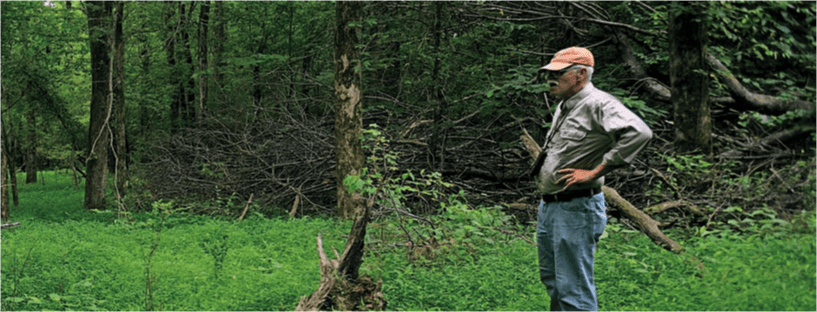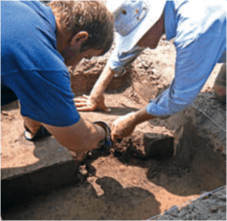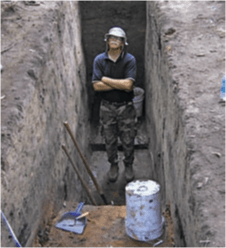This story was reprinted with permission of the Ole Miss Alumni Review. Summer 2009 Edition
Archaeologist Jay Johnson takes it in stride when students and colleagues compare him to the swashbuckling matinee idol Indiana Jones.
Johnson, who came to Ole Miss in 1976, even displays a poster of Jones (a gift from his students) on his office door. And, though Johnson hasn’t thwarted any Nazi plots or gone in search of ancient artifacts in India, his life as an archaeologist is not without its own excitement.
His work has included locating unmarked 18th-century graves in a Florida cemetery, exploring Indian mounds and unlocking the secrets of prehistoric stone tools.
As director of UM’s Center for Archaeological Research, Johnson has led nearly $4 million in research funded by grants from organizations including the U.S. Army Corps of Engineers, Tennessee Valley Authority, National Park Service, Soil Conversation Service, National Geographic Society, National Endowment for the Humanities, National Aeronautics and Space Administration, Mississippi Department of Archives and History and the National Audubon Society.
“Growing up in Florida, I didn’t realize that people could really be archaeologists. I thought they were people who wore pith helmets and had to go to Egypt to do their research,” says Johnson, whose interest in the profession was sparked by a freshman cultural anthropology class he took on a whim at Florida State University.
Inspired by the passion of his professor, he quickly decided that archaeology was a more interesting choice than his original major—math. Described now as the “prototypical archaeologist” by one of his UM colleagues, Johnson obviously made the right choice.

“I honestly can’t say enough wonderful things about him,” says Robbie Ethridge, associate professor of anthropology who has worked with Johnson since 2000 on a joint project studying the early Colonial period Chickasaw Indians. “He is very supportive of his colleagues, faculty and students, and is always generous in offering his time and opinion to so many who seek it.”
Johnson came to Ole Miss as a research associate after finishing his doctorate in anthropology at Southern Illinois University at Carbondale. His original assignment was to coordinate the analysis of a collection of stone tools recovered during the excavation of multiple prehistoric sites in northeast Mississippi.
Over the three decades since then, Johnson has been a leader in the field, particularly in adding the latest technology to the archaeologist’s traditional toolbox of shovels and brushes. He still does his share of digging and sifting, but that work is now much more targeted through the use of satellite imagery, infrared sensors and ground-penetrating radar.
Remote sensing, for example, is the use of high-technology instruments (such as satellites and magnetometers) to examine unseen characteristics of archaeological sites. Johnson was a pioneer in introducing this technique in Mississippi, and it is now used extensively because of its speed and noninvasive nature. If the archaeologist has a clear idea of what he is looking for and where it is, the chances of damaging or missing an artifact are reduced, Johnson says.
Before the new technologies came into use, an excavation required that crews spend several weeks dividing the site (sometimes as large as 100 acres) into quadrants and documenting surface artifacts to make an intelligent guess as to what lay below the surface. Today archaeologists have cut that time to mere days.
One of Johnson’s technological contributions is a low-altitude mapping technique that allows researchers to pinpoint significant areas hidden within prehistoric sites. Johnson fastened an infrared sensor to a tethered blimp and found he could use the device to “see” the actual floors of ancient dwellings, as well as graves and mounds.
“I have never found the golden statue with a ruby eye or a crystal skull, but I have found some very interesting facts about the past.” – Jay Johnson
In 2005-08, Johnson and Brian Haley, a former student who is now a research associate and coordinator of remote sensing for the Center for Archaeological Research, used remote sensing techniques to discover unmarked graves from the 18th century at St. Michael’s Cemetery in Pensacola, Fla. They used ground-penetrating radar, which they supplemented with thermal imaging, to detect caskets and grave shafts.

“The thermal imaging ‘sees’ it as a difference in temperature, and the ground-penetrating radar ‘sees’ it bounce off the radar energy,” Haley says. “Because human remains are involved it is important to use nonintrusive techniques.”
Historical documents indicated that in addition to the more than 3,200 marked graves, there were several others from the British occupation of the city from 1763-81. When the project is completed, Johnson and Haley should be able to put together a three-dimensional image of the cemetery that can distinguish graves from other objects in the ground such as rocks and tree roots.
It was Johnson’s leadership in using these new tools that brought him to the attention of the University of South Alabama’s Center for Archaeological Studies, which is organizing an exhibit showing archaeologists at work. And here is where the comparisons between Johnson and Indiana Jones draw a little closer.
In September 2008, Johnson flew to New York City, where he underwent the unusual experience of creating the cast for a life-size statue of himself.
“They took a cast of my body and a more detailed cast of my hands and face,” Johnson says. “Then they made the figure out of plastic polyurethane foam and coated that with plaster. Lastly, they sculpted [the figure] and painted it and added hair and detail to make it more lifelike.”
After the cast was made, Johnson sent the director of the exhibit his own field hat and some clothes to make the statue more authentic.
“He was the perfect choice for the exhibit,” colleague Ethridge says. “I mean, look at him. He is tall, thin and handsome with a great mustache; you cannot find anyone more appropriate to represent an archaeologist.”
Greg Waselkov, director of the exhibit and of the Center for Archaeological Studies at South Alabama, said he selected Johnson because of his research successes in the use of remote sensing and his expertise in stone tools used by prehistoric American Indians. The exhibit is scheduled to open in 2010.

All this attention has not turned Johnson’s head, however. He continues as usual with the work he has found so satisfying over the years. Johnson and a group of students are currently excavating a large site near Clarksdale, where they hope to uncover the remains of a large prehistoric ceremonial center.
“I have had the freedom to develop my research and have had a long line of very good students to share [my time with],” says Johnson. “Add that to a group of excellent colleagues and you have a situation that is hard to improve. I have never found the golden statue with a ruby eye or a crystal skull, but I have found some very interesting facts about the past.”
By Andrew Abernathy
Follow HottyToddy.com on Instagram, Twitter and Snapchat @hottytoddynews. Like its Facebook page: If You Love Oxford and Ole Miss…

